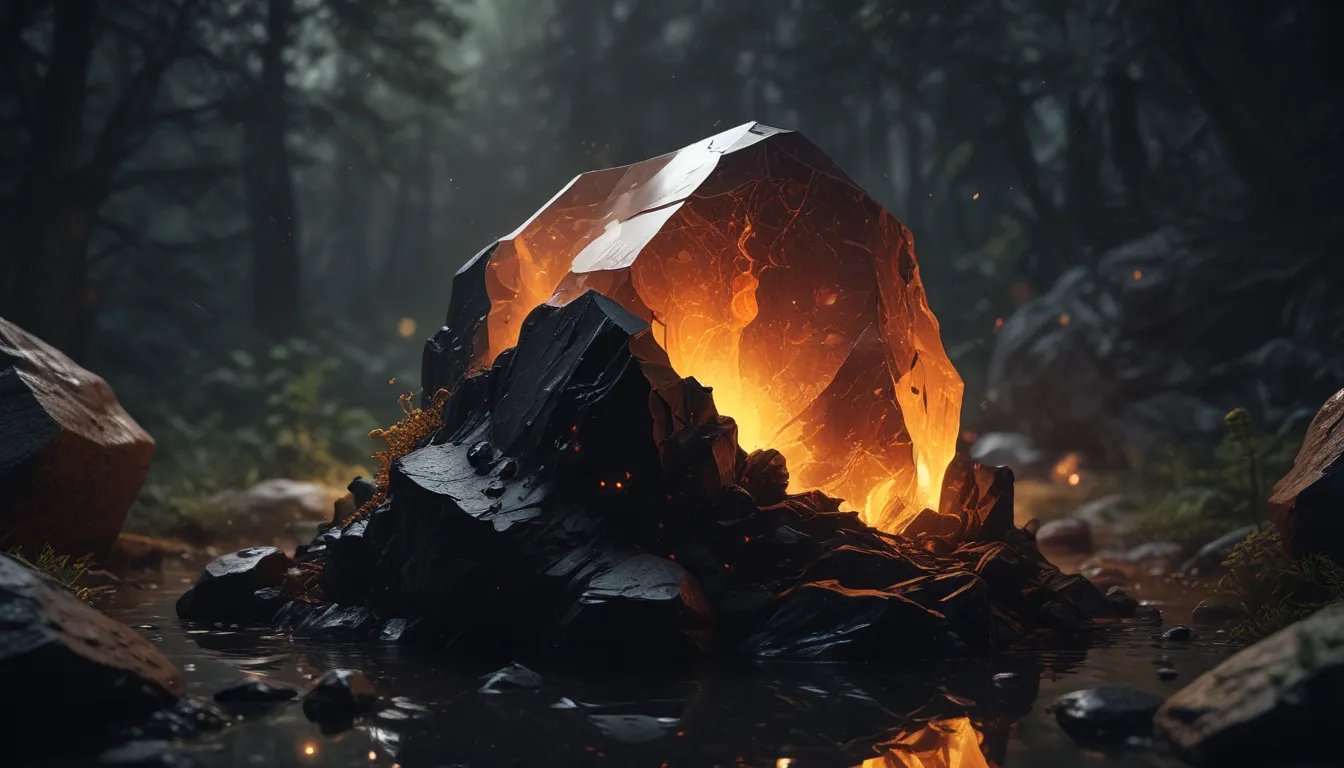A Note About Images: The images used in our articles are for illustration purposes only and may not exactly match the content. They are meant to engage readers, but the text should be relied upon for accurate information.
Obsidian, a mesmerizing natural glass born from the fiery depths of volcanic activity, has captured the attention of humanity for generations. Its glossy appearance and exceptional properties have not only fascinated scientists and historians but also intrigued spiritualists. In this article, we invite you to explore 20 captivating facts about obsidian, unveiling its geological origins, cultural significance, and modern-day uses. From its pivotal role in ancient tool-making to its application in contemporary surgical instruments, obsidian’s array of captivating characteristics continues to spark curiosity worldwide. Join us on a journey through the mesmerizing realm of obsidian, where the ancient past and cutting-edge science converge to reveal the secrets of this extraordinary material.
Unveiling the Marvels of Obsidian: A Closer Look at Its Fascinating World
- Obsidian, a volcanic glass renowned for its versatility, has served as a staple material for tools, jewelry, and spiritual practices.
- With a rich history steeped in ancient traditions, obsidian’s sharpness, durability, and array of colors make it a material of both practical and aesthetic value.
- Originating from volcanic eruptions, obsidian not only symbolizes protection but also serves as a vital tool for archaeological research and geological dating.
The Birth of Obsidian: A Natural Wonder Born from Fire
Obsidian, a natural volcanic glass, emerges from the swift cooling of lava, resulting in its signature glossy and smooth texture. Composed predominantly of silica, obsidian encompasses various hues such as black, brown, and even green due to impurities present during its formation.
Tools and Weapons of the Ancients: Obsidian’s Storied Past
Dating back to prehistoric eras, obsidian has been a pivotal material for crafting an array of tools and weapons owing to its acute edges and remarkable durability. Ancient civilizations such as the Aztecs and Greeks fashioned arrowheads, blades, and other cutting implements from obsidian, showcasing the material’s historical significance.
Spiritual Beliefs and Reverence: The Sacred Aura of Obsidian
Across diverse cultures, obsidian holds spiritual significance and is often associated with protective and healing properties. Believed to absorb negative energies and promote emotional well-being, obsidian is revered for its purported metaphysical qualities.
The Genesis of Obsidian: An Eruptive Tale of Creation
Obsidian takes shape during volcanic eruptions when lava rapidly cools, stifling mineral crystal formation. This rapid cooling process imbues obsidian with its characteristic glassy texture, distinguishing it from other materials.
Tracing Its Origins: The Ancient Roots of Obsidian
The moniker “obsidian” finds its origins in the Latin term “obsidianus,” denoting a stone discovered in Ethiopia. Known and utilized by humanity for millennia, this volcanic glass holds a place of prominence in ancient and contemporary contexts alike.
Cutting-Edge Precision: Obsidian’s Role in Surgical Scalpels
Renowned for its unparalleled sharpness and thin edges, obsidian is a preferred material for crafting surgical scalpels, offering a precise cutting tool for intricate medical procedures.
A Lustrous Affair: Obsidian in the World of Jewelry and Ornaments
The lustrous appearance and diverse color palette of obsidian render it a popular choice for crafting exquisite jewelry pieces and ornamental objects such as beads, pendants, and decorative carvings.
A Play of Light: The Translucency of Obsidian
Certain varieties of obsidian boast translucency, allowing light to permeate through and creating captivating visual effects. This unique attribute enhances obsidian’s allure in both jewelry and artistic endeavors.
Global Treasures: Obsidian’s Worldwide Presence
Obsidian reserves can be found in numerous locales across the globe, spanning regions with past or present volcanic activity. Noteworthy sources include the United States, Mexico, Japan, Turkey, and various parts of Europe.
A Geological Timepiece: Obsidian’s Role in Archaeological Investigations
Archaeologists leverage obsidian in studying ancient trade routes and human migration patterns. By scrutinizing the chemical composition of obsidian artifacts, researchers can pinpoint their origins to specific volcanic sources, shedding light on historical movements.
Reflecting the Past: Obsidian’s Legacy in Ancient Mirrors
Certain ancient cultures polished obsidian to fashion mirrors due to its reflective qualities. These mirrors held ceremonial value and were esteemed for their craftsmanship and symbolic significance.
Energy Work and Healing Traditions: Obsidian’s Spiritual Influence
In alternative medicine and holistic healing practices, obsidian is believed to possess grounding properties, serving as a conduit for energy work, meditation, and chakra alignment.
Enduring Strength: Obsidian’s Resilience Against the Elements
Resistant to weathering and corrosion, obsidian stands as a durable material, ensuring that artifacts fashioned from obsidian can withstand the test of time.
Unlocking the Past: Obsidian’s Role in Geological Dating
Geologists rely on obsidian for radiocarbon dating and as a means of determining the age of archaeological and geological specimens. This analytical technique aids in unraveling the timelines of past civilizations and events.
A Foundation of Stability: Obsidian’s Connection to the Root Chakra
In spiritual practices, obsidian is intertwined with the root chakra, symbolizing stability, grounding, and protection. It is believed to foster a deeper connection to the earth and instill a sense of security in individuals.
A Radiant Spectacle: Sheen and Rainbow Colors of Obsidian
Select variations of obsidian exhibit sheen or iridescence, producing captivating rainbow-like hues. This optical allure adds an enchanting dimension to the stone’s visual appeal.
Cutting-Edge Applications: Obsidian in Surgical and Industrial Blades
Due to its exceptional sharpness and hardness, obsidian serves as a favored material for manufacturing blades employed in surgical and industrial settings, where precision and durability are paramount.
Warding Off Negativity: Obsidian as a Symbol of Protection
Throughout history, obsidian has been venerated as a symbol of protection against malevolent energies and psychic intrusions. Often worn as an amulet or talisman, obsidian is esteemed for its shielding attributes.
Shamanic Traditions: The Spiritual Role of Obsidian
In shamanic practices, obsidian is utilized for spiritual protection and as a conduit for introspection and divination. Regarded as a potent aid in navigating the spiritual realms, obsidian holds significance in shamanic rituals.
Insights from the Ancients: Obsidian Artifacts Unveiling Ancient Cultures
The study of obsidian artifacts offers profound insights into the technological advancements and trade networks of ancient civilizations. By examining obsidian relics, researchers glean valuable information on customs, interactions, and societal structures of bygone eras.
Conclusion: Embracing the Mystique of Obsidian
In conclusion, obsidian reigns as a captivating natural glass with an illustrious history and a myriad of applications. As we journey through its enigmatic realm, we uncover not only its geological marvels but also its deep-rooted cultural and scientific significance. From its ancient origins to its contemporary allure in jewelry and cutting tools, obsidian continues to tantalize both scholars and enthusiasts. The allure of obsidian lies not solely in its exquisite appearance but also in its multifaceted cultural and scientific implications, rendering it a timeless source of intrigue and inspiration.
FAQs
What are the main properties of obsidian?
Obsidian is a volcanic glass characterized by a smooth, glossy texture and a conchoidal fracture pattern. While typically black, obsidian can also manifest in various shades of brown, gray, and green.
How is obsidian formed?
Obsidian comes into being through the rapid cooling of lava, often in the aftermath of volcanic eruptions. This swift cooling process impedes mineral crystallization, resulting in the formation of a non-crystalline, glassy substance.
In our quest to unravel the mysteries of obsidian, we encounter a realm brimming with historical significance, cultural relevance, and scientific intrigue. As we delve deeper into the enigmatic characteristics of this captivating material, we gain a newfound appreciation for the wonders of the natural world. Join us on this immersive journey through the extraordinary world of obsidian, where ancient wisdom and modern knowledge converge to illuminate its timeless allure.






